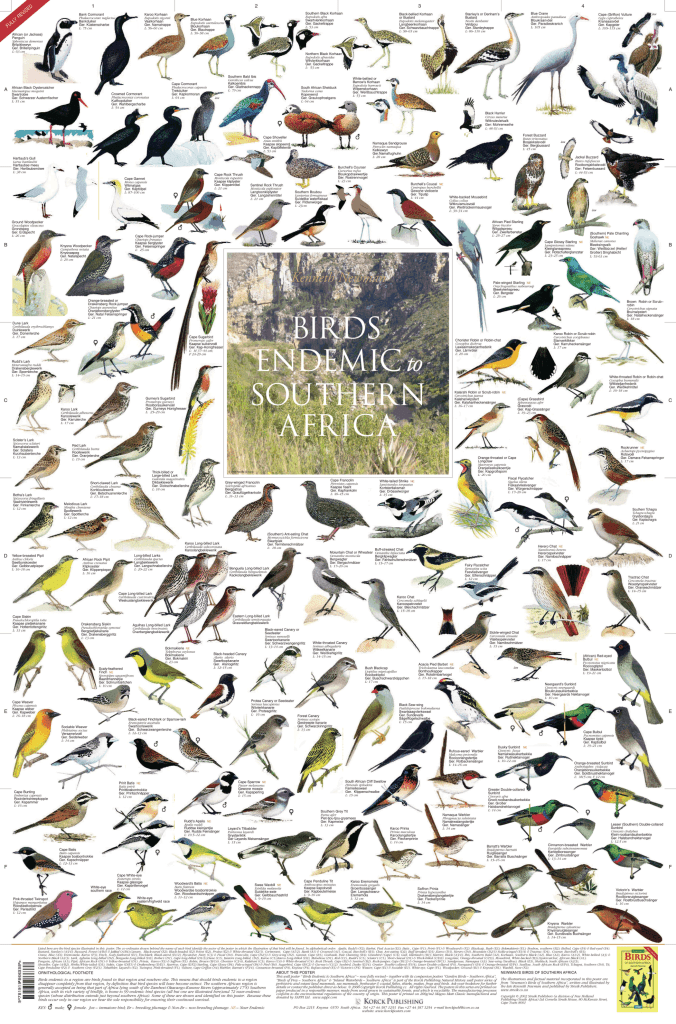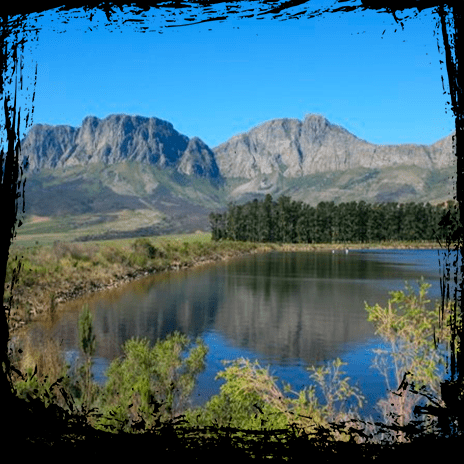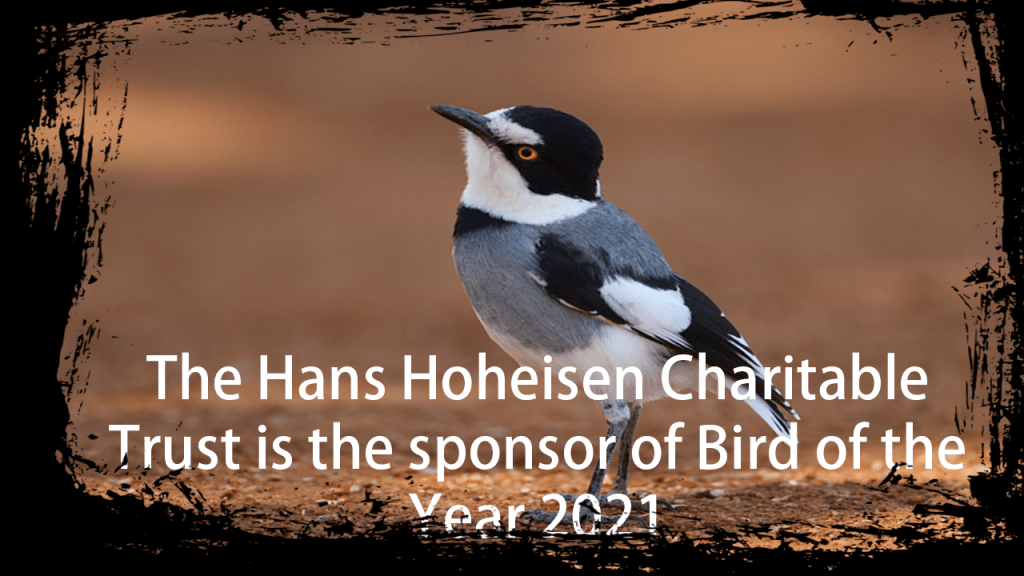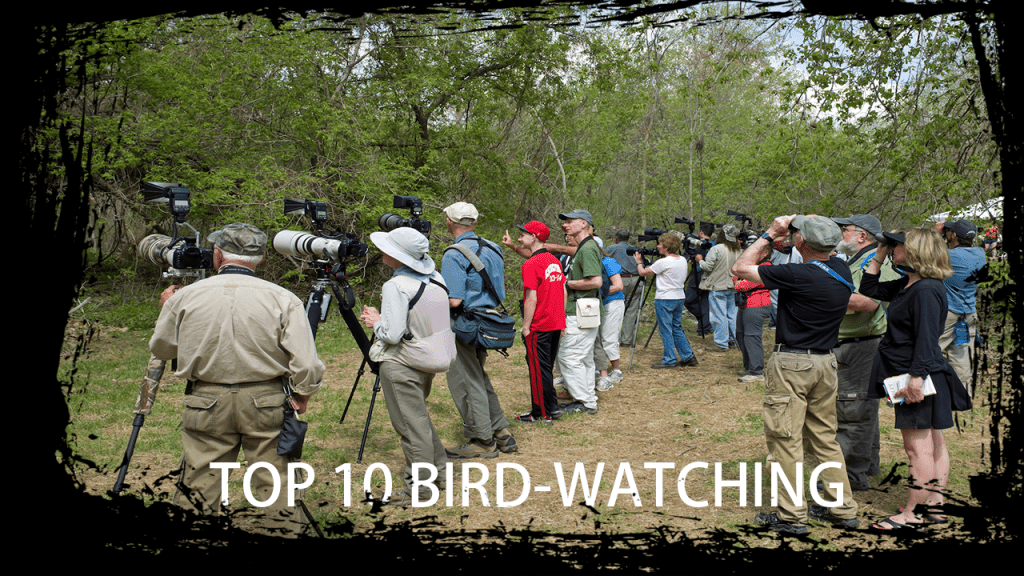ENDEMIC BIRDS OF THE WESTERN CAPE PROVINCE
The phrase “endemic species” refers to a species that is unique to a certain area and cannot be found anywhere else in the globe. It is fortunate that Southern Africa has a high amount of endemism in all living forms; in fact, some people rank South Africa as the third most biologically diverse nation in the world.
More breeding bird species can be found in the Southern African subregion than in the United States of America and Canada put together. This region is generally defined as the area of land south of the Cunene and Zambezi Rivers.

177 of the slightly more than 960 bird species found in the subregion are endemics or near-endemics, meaning they share very little of their habitat with nearby nations. In other words, over 20% of the bird species in Southern Africa are unique to that region alone! Due to the territory’s extensive and diversified range of habitats as well as its varied temperature, which varies from the chilly winter rainfall parts of the south west to the hot summer rainfall subtropical areas of the north and east, the region has a high level of endemism.
SOUTH COAST SPECIALS
Endangered and nearly extinct species found in this area include the South African Shelduck, Cape Shoveller, Cape Vulture, Forest Buzzard, Jackal Buzzard, Grey-winged Francolin, Cape Spurfowl, Blue Crane, Karoo Korhaan, Southern Black Korhaan, African Black Oystercatcher, Hartlaub’s Gull, Damara Tern, White-backed Mousebird, Acacia Pied Barbet, Knysna Woodpe Bokmakierie, Olive Bush-Shrike, Pied Starling, Cape Sugarbird, Orange-breasted, Southern & Greater Double-collared Sunbirds, Cape Batis, Cape Longclaw, Southern & Greater Double-collared Sunbirds, Southern Boubou, Southern Tchagra, Yellow canary, White-throated canary, Forest canary, Cape Siskin, Cape White-eye, Cape Sparrow, Cape Weaver, and Swee Waxbill.

STRANDVELD AND SALT MARSH
Endangered and nearly extinct species found in this area include the South African Shelduck, Cape Shoveller, Cape Vulture, Forest Buzzard, Jackal Buzzard, Grey-winged Francolin, Cape Spurfowl, Blue Crane, Karoo Korhaan, Southern Black Korhaan, African Black Oystercatcher, Hartlaub’s Gull, Damara Tern, White-backed Mousebird, Acacia Pied Barbet, Knysna Woodpe Bokmakierie, Olive Bush-Shrike, Pied Starling, Cape Sugarbird, Orange-breasted, Southern & Greater Double-collared Sunbirds, Cape Batis, Cape Longclaw, Southern & Greater Double-collared Sunbirds, Southern Boubou, Southern Tchagra, Yellow canary, White-throated canary, Forest canary, Cape Siskin, Cape White-eye, Cape Sparrow, Cape Weaver, and Swee Waxbill.

The following species are endemic or nearly endemic to this area: Cape Gannet, Cape & Crowned Cormorant, South African Shelduck, Cape Shoveller, Jackal Buzzard, Black Harrier, Grey-winged Francolin & Cape Spurfowl, Blue Crane, Southern Black Korhaan, African Black Oystercatcher, Hartlaub’s Gull, White-backed Mousebird, Acacia Pied Barbet, Karoo, Large-billed Southern Double-collared Sunbird, Pied Starling, Karoo Scrub-Robin, Layard’s & Chestnut-vented Tit Babbler, Cape Grassbird, Karoo Prinia, Grey-backed Cisticola, Fiscal Flycatcher, Cape Longclaw, Bokmakierie, Yellow Canary, and White-throated Canary.
In addition, the West Coast National Park offers strandveld birding and wader watching from hides with expansive views of salt marsh. A trip to the expansive mudflats (tide allowing) and salt pans near the mouth of the Berg River at Velddrif is another place to delight yourself. Additionally, the drive to Paternoster, which is located just north of Saldanha Bay, should yield larks, chats, and other local little brown jobs.
KAROO FLATS
Residents of Cape Town have the closest access to the numerous endemic species and specialities that are distinctive of the drier regions of Western South Africa on the Tanqua Karoo flats, which are located some distance beyond Ceres. One receives their first taste of the Karoo specialties at dawn, starting at Karoo Poort, the southernmost point of the Tanqua Karoo. Then, as you continue moving north, plan brief breaks in the nearby scrub as it gets progressively sparser, keeping an eye out for the species that are unique to this area.
The Skitterykloof valley is a great site to halt, where the steep, rocky slopes and acacia-lined river house a variety of tasty unique birds. Take the opportunity to stop several times at the narrow and treacherous Bain’s Kloof Pass on the way back to Cape Town to look for endemic birds found in the mountain fynbos. The route passes through stunning mountain passes and species-rich farming areas.
The following species are endemic or nearly endemic to this area: Greater Striped Swallow, Grey Tit, Cape Penduline Tit, Southern Black & Karoo Korhaan, White-backed Mousebird, Acacia Pied Barbet, Ground Woodpecker, Cape Clapper, Karoo, Large-billed, Karoo Long-billed & Spike heeled Lark, Grey-backed & Black-eared Sparrowlark, Namaqua Sandgro.

HOTTENTOTS HOLLAND TO PAARL
Several species that are hard to find on, or completely absent from, the Cape Peninsula can be accessed rather easily in the Hottentots Holland Mountains and their surroundings on the eastern side of the Cape Flats. The picturesque Rooiels area, the lofty ridges of Sir Lowry’s Pass, the well-known Helderberg Nature Reserve with its sprawling mature fynbos as well as the Paarl Mountain Reserve, the Paarl Bird Sanctuary, and some of the best wine estates are just a few of the places to visit in this area. These vineyards not only provide well-matured nectar from the vines but also draw many good bird species to the area.

Jackal Buzzard, Black Harrier, Grey-winged Francolin, Cape Spurfowl, Hartlaub’s Gull, Greater Striped Swallow, Cape Bulbul, Cape & Sentinel Rock Thrush, Cape Rock-jumper, Victorin’s Warbler, Cape Grassbird, Grey-backed Cisticola, Karoo Prinia, Fiscal Flycatcher, Cape Batis, Cape Longclaw, Southern Boubou, Cape Sugarbird.
THE CAPE ROCK-JUMPER IS THE BIRD OF THE YEAR 2021
One of South Africa’s most recognizable bird species is the Cape Rockjumper, which has red eyes and stunning coloration. It is a significant economic asset for South Africa since it is unique to the Fynbos Biome, and birdwatchers from across the globe come here to observe it and the other endemic species that are unique to the Cape Floral Kingdom. This bird family is unique to Lesotho and South Africa, where it coexists with its sister species, the Drakensberg Rockjumper.
This species was chosen as the “Bird of the Year” by BirdLife South Africa because it represents the Fynbos biome, a special plant kingdom that can only be found in South Africa. The Cape Sugarbird, Orange-breasted Sunbird, Protea Canary, Cape Siskin, Victorin’s Warbler, Agulhas Long-billed Lark, and Hottentot Buttonquail are seven other bird species that are unique to this area.The Fynbos covers an area that stretches from the northern Cederberg Mountains to Port Elizabeth, with slivers reaching as far as Makhanda/Grahamstown. In the CapeNature reserves of the Western Cape, the Fynbos is typically adequately protected, although there are serious worries about the development of alien tree species like pines and wattles as well as higher fire frequency brought on by climate change.
This vulnerability seems to be caused by a number of different things. First of all, considering that the bird lives in an area with dry summers, its physiology relies on water loss to stay cool. While adults simply cease foraging when the temperature rises, juveniles and chicks appear to be particularly susceptible to heat stress. Range modeling shows the species is confined to colder Fynbos habitats (notably at higher altitude). Additionally, there is data that indicates ground-based nests are becoming vulnerable to predators like Boomslang.

As a result, the Cape Rockjumper also represents a variety of other animal species whose distribution is equally constrained by what is referred to as a “climate envelope.” While some bird species may “follow” climate change by relocating to areas with better temperatures, those that are confined to the highest elevations are unable to do so because they are unable to climb higher. A variety of bird species, including the endangered Rudd’s and Botha’s larks, Sentinel Rock-thrush, Drakensberg Rockjumper, Ground Woodpecker, and Sentinel Rock-thrush, specialize in high altitude grasslands.
TOP 10 BIRD-WATCHING DESTINATIONS IN THE GREATER PLETTENBERG BAY REGION

1. Harkerville Forest and Kranshoek view point.
2. Robberg Nature Reserve.
3. Pelagic birding from Plett.
4. Goose Marsh.
5. Bitou River floodplain.
6. The Uplands farming area.
7. The Crags and Birds of Eden.
8. The plateaus above Nature’s Valley.
9. Nature’s Valley.
10. Tsitsikamma National Park.
Internationally recognized as a tourist attraction is the Bitou municipal district in the Garden Route region of the Western Cape Province of South Africa. Take into account, for example, the Cape Floral Kingdom, breathtaking land-, mountain-, and seascapes, whale- and dolphin-watching, native forests, different peoples, and the list goes on. The variety of bird species in the area is one of its biggest assets:
AFRICAN BLACK OYSTERCATCHER, PROTEA SEEDEATER, CAPE SISKIN, CAPE SUGARBIRD, ORANGE-BREASTED SUNBIRD, KNYSNA TURACO, KNYSNA and VICTORIN’S WARBLERS, KNYSNA WOODPECKER, and many others.
Additionally, a rapidly expanding birdwatching community needs to be properly introduced to a number of underutilized and ecologically diverse birding locations, including the Garden of Eden, Harkerville Forest, Robberg Nature Reserve, the Plettenberg Bay Sewage Works, the Bitou and Keurbooms Rivers and its estuary, Nature’s Valley, and others. This website includes the Tsitsikamma National Park because it is a component of the Plettenberg Bay Hope Spot. Additionally, it has been suggested that the Groot Biosphere Reserve be included to the Important Bird and Biodiversity Area (IBA) of Tsitsikamma National Park in the future.
There are already many intriguing birdwatching goods available: The migrating waders that frequent the Bitou River floodplain and the Keurbooms estuary are legendary, the forest birding at Nature’s Valley is recognized around the world, and the breeding colony of kelp gulls at Keurbooms Beach requires no introduction. The area also has a first-rate tourist infrastructure, and many lodging options are well-equipped to meet the needs of both domestic and foreign birders.


